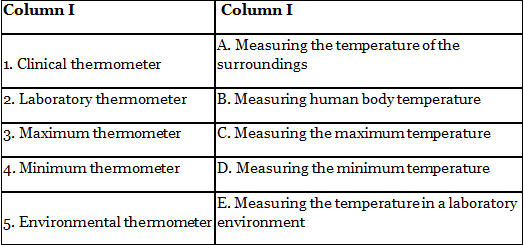Worksheets With Solutions: Temperature and Heat Class 7 Worksheet Science
Section A: Multiple Choice Questions (MCQs)
Q.1. What is temperature?
(a) The amount of heat in an object
(b) The measure of the average kinetic energy of the particles in an object
(c) The measure of the total kinetic energy of the particles in an object
(d) The measure of the potential energy of the particles in an object
Correct Answer is Option (b)
Temperature is the measure of the average kinetic energy of the particles in an object. It is a measure of how hot or cold an object is.
Q.2. Which of the following is not a temperature scale?
(a) Celsius
(b) Fahrenheit
(c) Kelvin
(d) Meter
Correct Answer is Option (d)
Meter is a unit of length and not a temperature scale. Celsius, Fahrenheit, and Kelvin are temperature scales.
Q.3. Which type of thermometer is used to measure body temperature?
(a) Mercury thermometer
(b) Alcohol thermometer
(c) Infrared thermometer
(d) Gas thermometer
Correct Answer is Option (d)
Infrared thermometers are used to measure body temperature. They measure the infrared radiation emitted by the body.
Q.4. Which of the following is a mode of heat transfer?
(a) Conduction
(b) Convection
(c) Radiation
(d) All of the above
Correct Answer is Option (d)
Conduction, convection, and radiation are all modes of heat transfer. Conduction is the transfer of heat through a material, convection is the transfer of heat through a fluid, and radiation is the transfer of heat through electromagnetic waves.
Q.5. Which of the following is an example of preventing loss of heat?
(a) Wearing warm clothes in winter
(b) Turning on a heater
(c) Covering a pot of hot soup with a lid
(d) All of the above
Correct Answer is Option (d)
Wearing warm clothes, turning on a heater, and covering a pot of hot soup with a lid are all examples of preventing loss of heat. They help to keep the heat inside and prevent it from escaping.
Section B: Short Questions
Q.1. Define heat.
Heat is a form of energy that is transferred from one object to another due to a temperature difference between them.
Q.2. Name the three temperature scales and give their respective freezing and boiling points of water.
The three temperature scales are Celsius, Fahrenheit and Kelvin. The freezing and boiling points of water on these scales are as follows:
Celsius: Freezing point = 0°C, Boiling point = 100°C
Fahrenheit: Freezing point = 32°F, Boiling point = 212°F
Kelvin: Freezing point = 273.15K, Boiling point = 373.15K
Q.3. Explain the working of a mercury thermometer.
A mercury thermometer works on the principle of thermal expansion. When the temperature rises, the mercury inside the glass tube expands and rises up the tube. The temperature is then read off the calibrated scale on the outside of the tube.
Q.4. Differentiate between conduction, convection and radiation.
Conduction is the transfer of heat through a material by the movement of particles, without any overall movement of the material itself. Convection is the transfer of heat through the movement of fluids (liquids or gases). Radiation is the transfer of heat through electromagnetic waves.
Q.5. Name some materials that are good conductors of heat.
Some materials that are good conductors of heat are metals (such as copper, aluminum and iron), silver, gold and brass.
Section C: Fill in the Blanks (5 marks)
Q.1. Temperature is the measure of ___________ in a body.
Heat
Q.2. Kelvin is the ___________ temperature scale.
Absolute
Q.3. A clinical thermometer is used to measure the temperature of the ___________.
Human body
Q.4. Convection is the mode of heat transfer in ___________.
Fluids
Q.5. Insulators are used to prevent the loss of ___________.
Heat
Section D: Match the Column (5 marks)
Match the type of thermometer with its use.

Section E: True or False (5 marks)
Q.1. Temperature is a measure of the amount of heat in a body. (True/False)
False
Temperature and heat are related but different concepts. Temperature is a measure of the intensity of heat, whereas heat is a form of energy.
Q.2. A clinical thermometer can be used to measure the temperature of an oven. (True/False)
False
A clinical thermometer is not designed to withstand high temperatures and should not be used to measure oven temperature.
Q.3. Heat always flows from hot objects to cold objects. (True/False)
True
Heat always flows from hot to cold objects until they are at the same temperature.
Q.4. Radiation of heat requires a medium to travel through. (True/False)
False
Radiation of heat does not require a medium to travel through. It can travel through a vacuum as well.
Q.5. Insulators are materials that allow heat to flow through them easily. (True/False)
False
Insulators are materials that do not allow heat to flow through them easily.
|
140 videos|108 docs|18 tests
|
|
140 videos|108 docs|18 tests
|

|
Explore Courses for Class 7 exam
|

|













